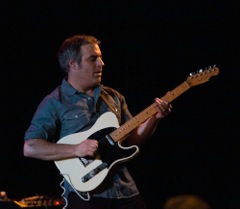
Photo by John Taber ©LiveShots
For over twenty years The Mother Hips, the musical architects of an enduring Northern California sound, have been laboring away creating brilliant albums, touring and influencing many in the current jamband circuit. Back in 1990 when the internet was a healthy bambino and George H. W. Bush was an unhealthy (for the nation) president—in the dorms of Chico State University a new sound was being cultivated, albeit, in a somewhat culturally empty landscape. In the northeast of the United States there was a confluence of bands that descended on the NYC club Wetlands Preserve, including Phish, Blues Traveler, The Spin Doctors and many others. But on the West Coast the embryonic Mother Hips were evolving in a cocoon, metamorphosing and growing colorful wings that were of a rare breed. Chico, California in 1990 was coming off decades of isolation, one of the few cities left in America that still had small town charm, a healthy interface between community and college students and cops, 150 local bands, the still unknown nationally Sierra Nevada Pale Ale and according to the SF Chronicle at the time the most LSD of any town in California. It was a sorcerer’s cauldron primed for an alchemical explosion—and, The Mother Hips were the result of the competing mystical factions ear-marking that Northern California Valley as the epicenter of something wonderfully weird.
The Mother Hips have been constantly redefining what an independent, regional band is capable of—with a new album in the works, tire tread being worn on national tours and showcases, The Mother Hips are still the dark horse. Being emphatically enigmatic is a blessing and a curse. But what do you expect from a band that emerged from between the cracks in the world? Shortly before appearing at Terrapin Crossroads late last month, co-founder Greg Loiacono took some time to revisit the long strange trip the band has been on.
“I’ve been freed from the past a prison I did not know that I was in till I was out.”
DNA: Hey Greg, what do you have on your plate today?
I have to drive my sister-in-law to the airport and then Noah, my son, has a baseball game. So I’m going to bring him to baseball. It’s all mild stuff.
DNA: You’re quite the family man.
GREG: That’s right.
DNA: Are you going to rehearse at Terrapin Crossroads for the shows this weekend?
GREG: We go in tomorrow at 11 in the morning to rehearse for a while. Have you been there?
DNA: My nephew is the manager of God Street Wine and they played there recently. One member, Jason Crosby stayed and has been hanging out with Bob Weir at TRI and Further. So be careful of those Grateful Dead people, they will steal your band mates.
GREG: I saw Tim do a couple of shows with Phil Lesh but I didn’t stay and meet him.
DNA: Right. Well, I’ve worked with you and the Mother Hips since the early days in Chico and I have no memory of you being fans of the Grateful Dead. Over the last couple of years you have integrated Dead songs into your repertoire notably “The Other One” and “Tennessee Jed.” Who initiated Dead songs in the Hips?
GREG: It was Tim (Bluhm, the other co-founder) because he had been hired by The Rhythm Devils to play with Mickey Hart and Bill Kreutzmann. It’s funny, because we were not into the Grateful Dead, but there was a period of time where because we were getting compared to jambands—we really wanted to distance ourselves from that. We were basically anti-that.
It was our reaction to not being pigeon-holed. In hindsight it might have been OK and we should have been more accepting. (laughs) It was synchronistic that right around the time we started playing some Dead songs I was at a music store called Watts Music in Novato and found a cassette of American Beauty —while I had heard most of the songs I had never owned it before. I bought it and brought it on the road and was like “Have you guys heard this before.” (Laughs) And once Tim got that gig we always listened to The Dead on the road.
“There’s a bird in a tree is he singing to me? Is he singing a song a song about remember when?”
DNA: When you guys got going back in 1990, the word jamband was a new term and everyone from Blues Traveler to Phish got lumped into this new genre. When Jerry Garcia died in 1995, fans and journalists were trying to piece together this post-Jerry world.
GREG: There was an article in Newsweek magazine when Jerry Garcia died with four different covers, I know because I have them. And there was an article about who would be the new Grateful Dead and they mentioned The Mother Hips. They had stars next to the band rating how likely it was, you know like 4 out of 5 stars. They listed the Allman Brothers, Phish, Blues Traveler, a few others and us and we had 4 stars! That was a strange thing for us because we never identified with that. Of course, over the last five years we have opened our minds and realized that we have a lot more connection to the scene than we previously thought. We have really enjoyed working with bands like Tea Leaf Green and ALO.


No Comments comments associated with this post